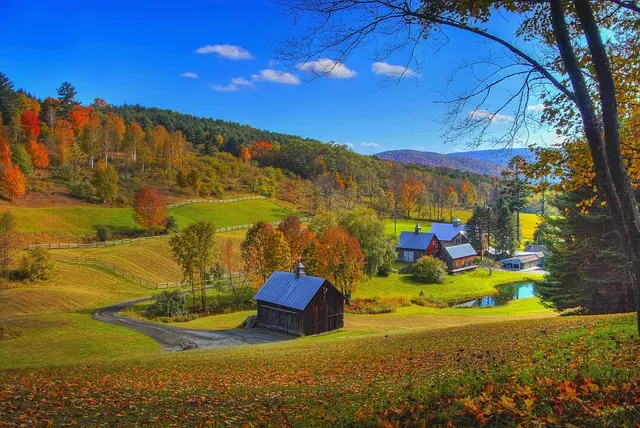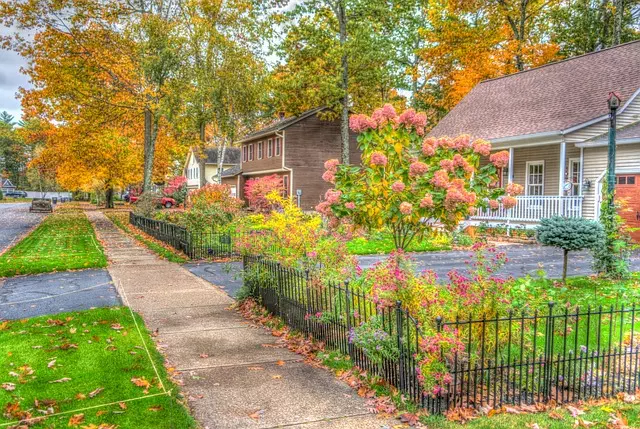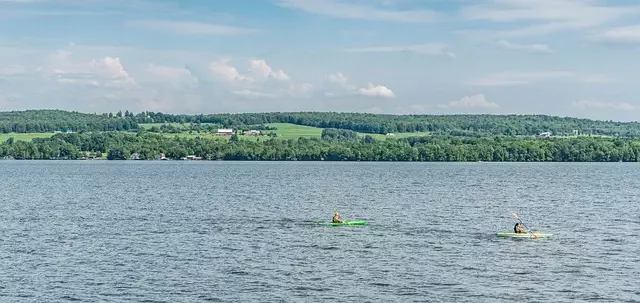Exploring Vermont's botanical gardens is a must for anyone consulting a Vermont travel guide and looking for things to do in Vermont. These living museums, including the ECHO, Leahy Center for Lake Champlain, the University of Vermont Botanical Garden, and other local gems like the Eleanor T.Yuengling Memorial Forest Garden at The Arboretum and the Charlotte Grange Garden, offer year-round beauty that changes with each season. From the vibrant colors of spring to the tranquil hues of summer, the spectacular displays of fall, and the stark elegance of winter, these gardens are not just places of serene contemplation but also centers for environmental education and biodiversity conservation. They are integral to Vermont's rich cultural landscape and provide a rewarding and educational experience for visitors seeking the best places to visit in Vermont.
Embark on a verdant journey through Vermont’s lush landscapes with our comprehensive guide to its most enchanting botanical gardens. This article serves as a Vermont travel guide, illuminating the best places to visit in Vermont for garden enthusiasts and nature lovers alike. From the vibrant flora of the state’s top botanical havens to the unique biodiversity they harbor, discover activities, events, and seasonal highlights that make Vermont a must-visit destination for things to do in Vermont. Plan your exploration with our tailored travel tips, ensuring an unforgettable experience amidst nature’s splendor.
- Exploring the Lush Landscapes: A Guide to Botanical Gardens in Vermont
- Vermont's Natural Wonders: The Top Botanical Gardens to Visit
- Immersive Experiences: Activities and Events at Vermont Botanical Gardens
- The Beauty of Biodiversity: Highlighting Unique Plant Species in Vermont
- Vermont's Best Kept Secrets: Lesser-Known Botanical Havens
- Seasonal Splendor: What to See at Vermont Botanical Gardens Throughout the Year
- Travel Tips for Garden Enthusiasts in Vermont: Planning Your Visit
Exploring the Lush Landscapes: A Guide to Botanical Gardens in Vermont

Embarking on a journey through Vermont’s verdant valleys and rolling hills reveals a hidden gem for nature enthusiasts and botanical aficionados alike: its network of botanical gardens. These living museums are not just tranquil retreats but also vibrant compendiums of plant life, showcasing the region’s floral diversity. For those consulting a Vermont travel guide in search of the best places to visit, these gardens offer a serene interlude among breathtaking landscapes and exotic plant species. Each garden is meticulously designed to educate and inspire, providing visitors with unique insights into botany, horticulture, and environmental conservation. The Chittenden Botanical Garden in Waterbury, for instance, is a 25-acre expanse that features native plants, themed gardens, and educational programs that are perfect for all ages. Similarly, the ECHO Lake Aquarium and Science Center in Burlington offers not only aquatic life but also a variety of plant collections within its 160-acre setting on the shores of Lake Champlain. These verdant havens are among the top things to do in Vermont for those looking to immerse themselves in the state’s natural beauty and diverse ecosystems. Whether you’re a local or a traveler, these botanical gardens provide a refreshing and informative experience that encapsulates the essence of Vermont’s connection with nature.
Vermont's Natural Wonders: The Top Botanical Gardens to Visit

Embarking on a journey through Vermont’s natural wonders is an enchanting experience for any nature enthusiast or casual traveler alike. The state’s botanical gardens are not just green havens but also serve as living classrooms showcasing the diversity of plant life and the beauty of horticulture. For those consulting a Vermont travel guide, these gardens offer a serene escape from the bustle of daily life. Eagle-eyed visitors can explore the lush landscapes of The Eleanor Jackson and Woodward Trolley Garden in Stowe, which boasts a remarkable collection of plants native to New England, complete with a variety of themed gardens. This picturesque setting is perfect for a leisurely stroll or a contemplative bench session, making it one of the best places to visit in Vermont for those interested in botany and biodiversity. Similarly, the Vermont State Botanical Area at UVM offers an immersive experience with its extensive network of gardens, which include a native plant garden, perennial borders, and a formal French parterre, among others. It’s a must-visit for anyone looking for things to do in Vermont that combines education with the tranquility of nature’s artistry. These destinations not only provide a tranquil retreat but also offer insights into sustainable gardening practices and conservation efforts, making them valuable additions to any Vermont travel itinerary. Whether you’re a local or a tourist, these botanical wonders are sure to be highlights in your exploration of the Green Mountain State.
Immersive Experiences: Activities and Events at Vermont Botanical Gardens

The Vermont Botanical Gardens offer a rich array of immersive experiences for visitors seeking a connection with nature and an enriching educational experience. These gardens are a key inclusion in any Vermont travel guide, as they provide a serene environment where one can engage with the diverse flora that thrives in this New England state. Throughout the year, the gardens host a variety of events and activities that cater to all ages and interests, making them one of the best places to visit in Vermont for both residents and travelers alike. From guided tours that delve into the intricacies of plant life to workshops on sustainable gardening practices, these events are designed to deepen visitors’ appreciation for the natural world and its preservation. Special seasonal activities, such as maple sugaring demonstrations in the spring and harvest festivals in the fall, offer unique insights into the local traditions and ecosystems. The gardens also play host to themed events like the Herb and Butterfly Festival, which provides an interactive and educational experience for attendees to learn about these fascinating creatures and their role in the ecosystem. These activities not only enrich the visitor’s experience but also underscore the importance of botanical conservation and environmental stewardship, making a trip to the Vermont Botanical Gardens a meaningful addition to any itinerary for things to do in Vermont. Whether one is a seasoned gardener or simply an admirer of nature’s beauty, the Vermont Botanical Gardens offer an array of opportunities to explore, learn, and enjoy the best places to visit in Vermont in a truly immersive way.
The Beauty of Biodiversity: Highlighting Unique Plant Species in Vermont

Vermont’s botanical gardens serve as living museums, showcasing the rich tapestry of plant life that thrives within the state’s diverse ecosystems. These horticultural havens are not just tranquil spots for leisurely strolls; they are also centers for biodiversity and conservation efforts. Visitors to these gardens, as highlighted in the Vermont travel guide, can witness a grand display of unique flora, from native wildflowers to rare exotic species. The ECHO Leahy Center for Lake Champlain, for instance, blends botanical beauty with environmental education, offering insights into both local and global biodiversity issues.
The best places to visit in Vermont for those interested in the floral splendor include the Robert Frost Garden at St. Michael’s College, which honors the poet’s legacy with a landscape that reflects his intimate connection with nature. Additionally, the Vermont Botanical Garden at the University of Vermont is a must-see, featuring both native plants and themed gardens that are not only aesthetically pleasing but also serve as living examples of ecological preservation and sustainable horticulture practices. These gardens are not merely destinations for things to do in Vermont; they are immersive experiences that highlight the importance of plant diversity and the ongoing efforts to protect it.
Vermont's Best Kept Secrets: Lesser-Known Botanical Havens

Embarking on a verdant journey through Vermont reveals a wealth of natural wonders, often overshadowed by the state’s acclaimed ski slopes and quaint rural charm. For those who seek an immersion in botanical beauty beyond the well-trodden paths, Vermont harbors several lesser-known havens that beckon nature enthusiasts and travelers alike. These verdant sanctuaries, though not as celebrated as the Green Mountains themselves, are just as captivating for those consulting a Vermont travel guide or exploring the best places to visit in Vermont.
One such hidden gem is the ECHO, Leahy Center for Lake Champlain, which offers a unique blend of botanical displays and interactive exhibits focused on aquatic life. The surrounding gardens are a kaleidoscope of native plants that change with the seasons, providing a serene backdrop for contemplation and discovery. Another underrated spot is the University of Vermont Botanical Garden, which provides a living classroom of New England’s flora, complete with themed gardens and a network of walking paths ideal for things to do in Vermont that are both relaxing and enlightening. These under-the-radar botanical havens offer travelers a chance to connect with the natural splendor of Vermont, often leading to unforgettable experiences that stand as quiet testaments to the state’s diverse and thriving ecosystems.
Seasonal Splendor: What to See at Vermont Botanical Gardens Throughout the Year

Exploring the seasonal splendor of Vermont’s botanical gardens is a journey through a kaleidoscope of natural beauty that complements any Vermont travel guide or list of the best places to visit in Vermont. As the seasons transition, each brings its own unique display within these verdant sanctuaries. In spring, an array of blooming flowers, including daffodils and tulips, herald the warmer weather. The gardens are alive with the vibrant colors and sweet fragrances that signal new beginnings and growth. Summer sees a lush backdrop of greenery, punctuated by the occasional burst of color from perennials and annuals, providing a tranquil setting for leisurely strolls or contemplative moments amidst nature’s grandeur.
As fall arrives, the botanical gardens in Vermont transform into a living canvas of fiery reds, warm oranges, and golden yellows, with maples, oaks, and sweetgums putting on an unforgettable show. Visitors can wander through the changing landscape, capturing memories and experiencing the serene beauty that characterizes things to do in Vermont during this enchanting season. The cooler months bring their own charm with evergreens and winter berries forming a stark yet harmonious contrast against the snow-covered grounds. Each garden offers a unique perspective on the changing seasons, making it a must-visit for nature enthusiasts and travelers alike throughout the year. Whether planning a visit in spring, summer, fall, or winter, these botanical gardens are a testament to Vermont’s natural wonders and a highlight for any itinerary exploring the best places to visit in Vermont.
Travel Tips for Garden Enthusiasts in Vermont: Planning Your Visit

When planning your visit to the botanical gardens of Vermont, it’s advisable to refer to a comprehensive Vermont travel guide to make the most of your experience. The Green Mountain State is not just about its famous maple syrup; it’s also home to a diverse array of flora that thrives in its varied climates. For garden enthusiasts, the best places to visit in Vermont include the Eleanor T.Yuengling Memorial Forest Garden at The Arboretum, which showcases native plants and has miles of trails for leisurely strolls or more vigorous hikes. Another must-visit is the Charlotte Grange Garden, a quintessential New England garden with perennials that bloom from spring to fall.
To enhance your visit, consider the seasons; each brings its own beauty and a different set of things to do in Vermont. Spring unveils vibrant blossoms, summer offers lush greenery and blooming annuals, fall presents a kaleidoscope of autumn foliage, and winter showcases the resilience of evergreens and berry-laden branches. Pack appropriate clothing for variable weather conditions, as Vermont’s climate can be unpredictable even within a single day. Additionally, check the opening hours of each garden in advance, as they may vary throughout the year. Some gardens may offer special events or guided tours during certain times, which provide valuable insights into the local plant life and garden history. To ensure you don’t miss out on these enriching experiences, plan your visit around these events. With careful planning and a reliance on a Vermont travel guide, your trip to the botanical gardens of Vermont will be both memorable and informative.
